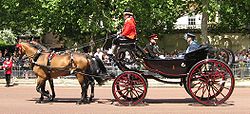Barouche


A barouche was a type of horse-drawn carriage fashionable in the 19th century. Developed from the calash of the 18th century,[1] it was a four-wheeled, shallow vehicle with two double seats inside, arranged vis-à-vis, so that the sitters on the front seat faced those on the back seat. It had a soft collapsible half-hood folding like a bellows over the back seat and a high outside box seat in front for the driver. The entire carriage was suspended on C springs. It was drawn by a pair of high-quality horses and was used principally for leisure driving in the summer. A light barouche was a barouchet or barouchette. A barouche-sociable was described as a cross between a barouche and a victoria.
The word barouche is an anglicisation of the German word barutsche, via the Italian baroccio or biroccio and ultimately from the Latin birotus, "two-wheeled". The name thus became a misnomer, as the later form of the carriage had four wheels.
Calash



The earlier carriage type, called calash or calèche, was also a light carriage with small wheels, inside seats for four passengers, a separate driver's seat and a folding top. A folding calash top was a feature of two other types: the chaise, a two-wheeled carriage for one or two persons, a body hung on leather straps or thorough-braces, usually drawn by one horse; and a victoria, a low four-wheeled pleasure carriage for two with a raised seat in front for the driver.
In Quebec, Canada, calèche refers to a two-wheeled horse-drawn vehicle with or without a folding top and with a driver's seat on the splashboard.[2]
In the Philippines, the kalesa is a one-horse descendant of Spanish Colonial calashes, and is a common sight in older cities such as Manila and Vigan.
See also
Notes
- ^ Casanova mentions a calèche à 2 roues (two-wheeled calash) first in 1742, a calèche à 4 roues (four-wheeled calash) in 1758 (Gunther)
- ^ Musée McCord Museum - Caleche, Dufferin Terrace, Quebec City, QC, about 1920. McCord Museum of Canadian History, Montreal, Quebec.
References
- B1499 Horse-drawn carriage, barouche, timber / metal / glass / leather / textile, made by Shanks and Co, London, England, used by John Brown Watt in Sydney before 1888 - Powerhouse Museum Collection. Search barouche. Powerhouse Museum, Sydney, Australia.
- Barouche: Definition with Barouche Pictures and Photos. Lexicus.
- Freesound :: view sample :: CalecheDownAlley.wav, Institut Universitari de l'Audiovisual (Institute of Audiovisual Studies), Universitat Pompeu Fabra, Barcelona, Spain. Sound file.
